Hermanson G. Bioconjugate Techniques, Second Edition
Подождите немного. Документ загружается.

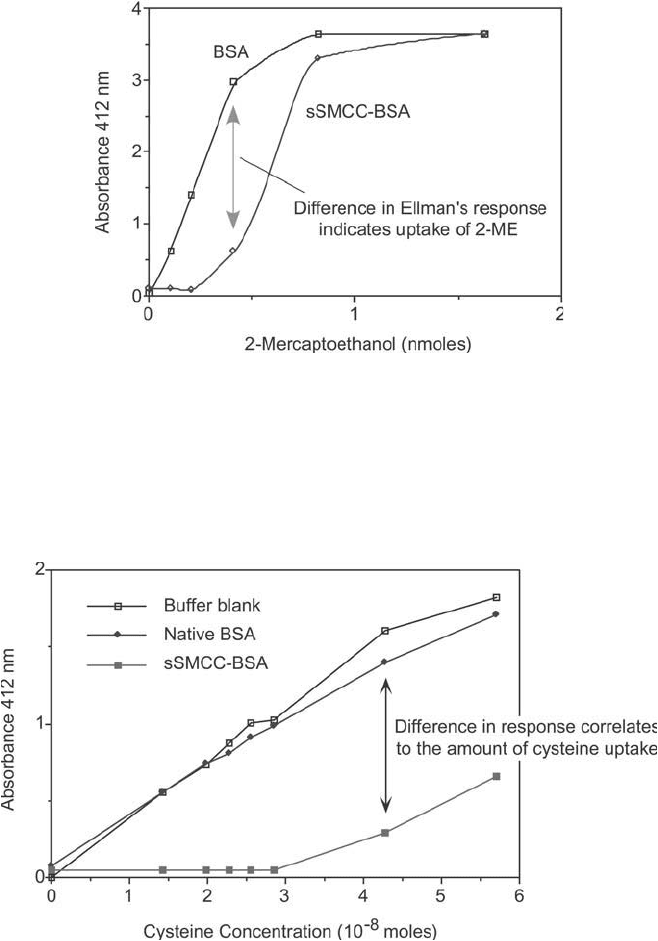
770 19. Preparation of Hapten–Carrier Immunogen Conjugates
Figure 19.19
An Ellman ’s assay may be done to determine the maleimide activation level of SMCC-derivatized
proteins. Reaction of the activated carrier with different amounts of 2-mercaptoethanol results in various levels
of sulfhydryls remaining after the reaction. Detection of the remaining thiols using an Ellman ’s assay indirectly
indicates the amount of sulfhydryl uptake into the activated carrier. Comparison of the Ellman ’s response to the
same quantity of 2-mercaptoethanol plus an unactivated carrier indicates the absolute amount of sulfhydryl that
reacted. Calculation of the maleimide activation level then can be done.
Figure 19.20 Cysteine also may be used in an Ellman ’s assay to determine the maleimide activation level of
SMCC-derivatized proteins. Reaction of the activated carrier with different amounts of cysteine results in vari-
ous levels of sulfhydryls remaining after the reaction. The coupling must be done in the presence of EDTA to
prevent metal-catalyzed oxidation of sulfhydryls. Detection of the remaining thiols using an Ellman ’s assay indi-
rectly indicates the amount of sulfhydryl uptake into the activated carrier. Comparison of the Ellman ’s response
to the same quantity of cysteine plus an unactivated carrier indicates the absolute amount of sulfhydryl that
reacted. Calculation of the maleimide activation level then can be done.
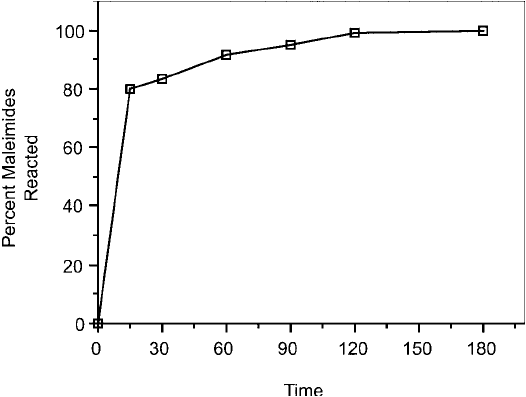
Protocol
1. Dissolve the carrier of choice at a concentration of 10 mg/ml in 0.1 M sodium phosphate,
0.15 M NaCl, pH 7.2–7.5 (activation buffer).
Note : For use of native, multi-subunit KLH, increase the NaCl concentration to 0.9 M.
2. Dissolve sulfo-SMCC (Thermo Fisher) at a concentration of 10 mg/ml in the activation
buffer. Immediately transfer the appropriate amount of this crosslinker solution to the
vial containing the dissolved carrier protein.
Note: The amount of crosslinker solution to be transferred is dependent on the level of acti-
vation desired. Suitable activation levels can be obtained for the following proteins by adding
the indicated quantities of the sulfo-SMCC solution. The degree of sulfo-SMCC modifi cation
often determines whether the carrier will maintain solubility after activation and coupling to a
hapten. Multimeric KLH in particular, is sensitive to the amount of crosslinker addition. KLH
usually retains solubility at about 0.1–0.2 times the mass of crosslinker added to BSA. This
level of addition still results in excellent activation yields, since KLH is signifi cantly larger than
most of the other protein carriers.
Add the following quantities of sulfo-SMCC solution to each ml of carrier protein solution:
(a) BSA: 500 l
(b) cBSA: 200 l
(c) OVA: 500 l
(d) KLH: 100 l
Figure 19.21 The rate of reaction of cysteine with maleimide-activated BSA was determined using an Ellman ’s
assay for remaining sulfhydryl groups after the reaction, according to Figure 19.20. Nearly all of the available
maleimides are coupled with sulfhydryls within 2 hour.
5. NHS Ester-Maleimide Heterobifunctional Crosslinker-Mediated Hapten–Carrier Conjugation 771
772 19. Preparation of Hapten–Carrier Immunogen Conjugates
Carriers having similar molecular weights to that of BSA or OVA may be activated at the
same level with good success. cBSA requires less crosslinker addition due to its greater quantity
of amines present.
3. React for 1 hour at room temperature.
4. Immediately purify the activated carrier protein by gel fi ltration using a desalting resin
with a bed volume equal to 15 times the volume of the activation reaction. To perform
the chromatography use 0.1 M sodium phosphate, 0.15 M NaCl (0.9 M for KLH), 0.1 M
EDTA, pH 7.2–7.5 (conjugation buffer). The EDTA is present to prevent metal-catalyzed
sulfhydryl oxidation to disulfi des, which will result in an inability to couple to the male-
imide groups on the carrier. This is a particular problem when using BSA due to contam-
inating iron from hemolysis. Concentrations less than 0.1 M EDTA will not fully inhibit
the oxidation reaction, especially if a cysteine-containing peptide is to be conjugated to
the activated carrier. Apply the sSMCC/carrier reaction mixture to the column while col-
lecting 0.5–1.0 ml fractions. Pool the fractions containing the activated carrier (the fi rst
peak to elute from the column), and discard the fractions containing excess sulfo-SMCC
(the second peak). The activated carrier should be used immediately or freeze dried to
maintain maleimide stability.
5. Dissolve a sulfhydryl-containing hapten or peptide to be conjugated at a concentration
of 10 mg/ml in the conjugation buffer. Other hapten concentrations may be used depend-
ing on its solubility. If an excess of the peptide solution is made at this time, an estimate
of the degree of conjugation may be determined later (see section below). Add this solu-
tion to the pooled fractions containing the activated carrier at an equivalent mass ratio
(1 mg hapten per mg of the carrier). Alternatively, the peptide may be added in solid form
directly to the activated carrier solution if it is known to be freely soluble and can be
weighed out in the appropriate quantity.
6. Allow the conjugation reaction to proceed for 2 hours at room temperature.
7. The hapten–carrier conjugate now may be mixed with adjuvant and used for injection
purposes without further purifi cation.
An estimate of the degree of conjugation may be made by assaying the amount of sulfhydryl
present before and after the coupling reaction. A portion of the peptide solution before mixing
with the activated carrier should be saved to compare with the reaction mixture after the conju-
gation is complete. The comparison is made using a solution of Ellman ’s reagent (5,5 -dithiobis-
(2-nitrobenzoic acid), which reacts with sulfhydryls to form a highly colored chromophore
having an absorbance maximum at 412 nm (
412 nm
10
4
/cm
1
M
1
) (Chapter 1, Section 4.1).
A generalized procedure is presented here. Modifi cations to this guideline may have to be made
for each individual peptide to obtain the appropriate response to the Ellman ’s reagent. For
reactions done with very small quantities of peptide, the Ellman ’s assay may not be sensitive
enough to measure the degree of conjugation.
1. Using a microtiter plate (96 well) dispense 200 l of 0.1 M sodium phosphate, 0.15 M NaCl,
0.1 M EDTA, pH 7.2 (conjugation buffer) into each well to be used.
2. Add 10 l of the peptide solution before conjugation to the appropriate wells in
duplicate.
3. Add 10 l of the reaction mixture after the conjugation reaction is complete to another
set of wells in duplicate.
4. Add 20 l of Ellman ’s reagent (1 mg/ml dissolved in the gel fi ltration purifi cation buffer)
to each well including one containing only buffer (220 l) to use as a blank.
5. Incubate for 15 minutes at room temperature.
6. Measure the absorbance of all wells using a microplate reader with a fi lter set at 410 nm.
A comparison of the blank corrected values before and after conjugation should give an
indication of the percent of peptide coupled. To be more quantitative, a standard curve must be
run to focus in on the linear response range of the peptide-Ellman ’s reaction. Using cysteine as
a representative sulfhydryl compound (similar in Ellman ’s response to a peptide having one free
sulfhydryl), it is possible to obtain very accurate determinations of the amount which coupled
to the activated carrier. Figure 19.20 , discussed previously in this section, shows the results of
this type of assay.
6. Active-Hydrogen-Mediated Hapten–Carrier Conjugation
Conjugation chemistry for the coupling of haptens to carrier molecules is fairly well defi ned
for compounds having common functional groups to facilitate such attachment. The types of
functional groups generally useful for this operation include easily reactive components such as
primary amines, carboxylic acids, aldehydes, or sulfhydryls.
However, for hapten molecules containing no easily reactive functional groups, conjugation
can be diffi cult or impossible using current technologies. To solve this problem, demanding
organic synthesis is frequently required to modify the hapten molecule to contain a suitable
reactive portion. Particularly, certain drugs, steroidal compounds, dyes, or other organic mol-
ecules often have structures that contain no available “ handles ” for convenient crosslinking.
Frequently, these diffi cult-to-conjugate compounds do have certain suffi ciently active hydro-
gens that can be reacted with a carrier molecule using specialized reactions designed for this
purpose. This section describes two choices for this conjugation problem, the diazonium proce-
dure and the Mannich reaction. Both of them are able to crosslink haptens through any avail-
able active hydrogen to carrier molecules, resulting in immunogens suitable for injection.
6.1. Diazonium Conjugation
Diazonium coupling procedures have been used for many years in organic synthesis and for
crosslinking or immobilization of active-hydrogen-containing compounds (Inman and Dintzis,
1969; Cuatrecasas, 1970). Diazonium derivatives can couple with haptens containing avail-
able phenolic or, to a lesser extent, imidazole groups in an electrophilic substitution reaction
(Riordan and Vallee, 1972). They also may undergo minor secondary reactions with sulfhydryl
groups and primary amines (Chan et al ., 1975).
The most important reaction of a diazonium group, however, is with available tyrosine and
histidine residues within peptide haptens, rapidly creating diazo linkages. This method of con-
jugation is especially useful for site-directed crosslinking of tyrosine-containing peptides. Since
tyrosine usually is present only in limited quantities in a given peptide, use of diazonium con-
jugation can crosslink and orient all peptide molecules in an identical fashion on a carrier. The
result is excellent reproducibility in preparation of the immunogen, and a consistent presenta-
tion of the peptide on the surface of the carrier to the immune system for antibody production.
6. Active-Hydrogen-Mediated Hapten–Carrier Conjugation 773
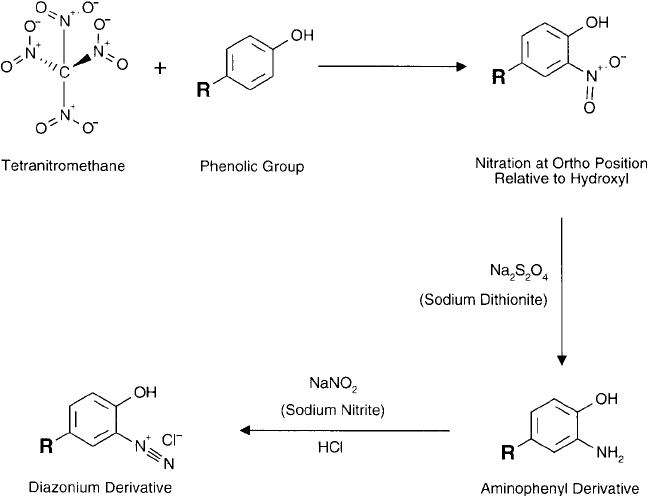
774 19. Preparation of Hapten–Carrier Immunogen Conjugates
Derivatives of carbohydrate antigens also have been coupled to carrier proteins through the
use of an intermediate diazonium group (McBroom et al., 1976). In this case, an aminophenyl
glycoside was prepared by reaction of the reducing end of the oligosaccharide with -( p -
aminophenyl)ethylamine and then forming the diazotized derivative with sodium nitrite (Zopf
et al., 1978). Upon mixing with carrier proteins containing tyrosine residues, the carbohydrate
derivative is coupled via a diazo bond.
Creation of a diazonium group on phenolic compounds or tyrosine side-chain groups is
possible by forming an intermediate nitrophenol derivative. Reaction of tyrosine-containing
proteins and peptides with tetranitromethane effectively nitrates the ring in the ortho position
(Vincent et al., 1970). Reduction of the nitro group to an amine then is done using sodium
dithionite (sodium hydrosulfi te; Na
2
S
2
O
4
) (Sokolovsky et al., 1967; Chapter 1, Section 4.3).
The aminophenol derivative fi nally is reacted with sodium nitrite in acidic conditions to form
the highly reactive diazonium group ( Figure 19.22 ). Once created, the diazonium compound
must be added immediately to the conjugation reaction, since the species is extremely unstable
in aqueous environments.
The active diazonium typically is a colored compound, sometimes orange, dark brown, or
even black in concentrated solutions. The conjugated immunogen usually is deeply colored due
to the resultant diazo bond. The coupling reaction is performed at alkaline pH, optimally at
pH 8 for histidine residues and pH 9–10 for tyrosine groups. In practice, however, it is
not possible to target a histidine group in the presence of a tyrosine group without some
cross-reactivity.
Figure 19.22 Phenolic compounds may be derivatized to contain reactive diazonium groups by nitration
with tetranitromethane followed by reduction with sodium dithionite and diazotization with sodium nitrite in
dilute HCl.
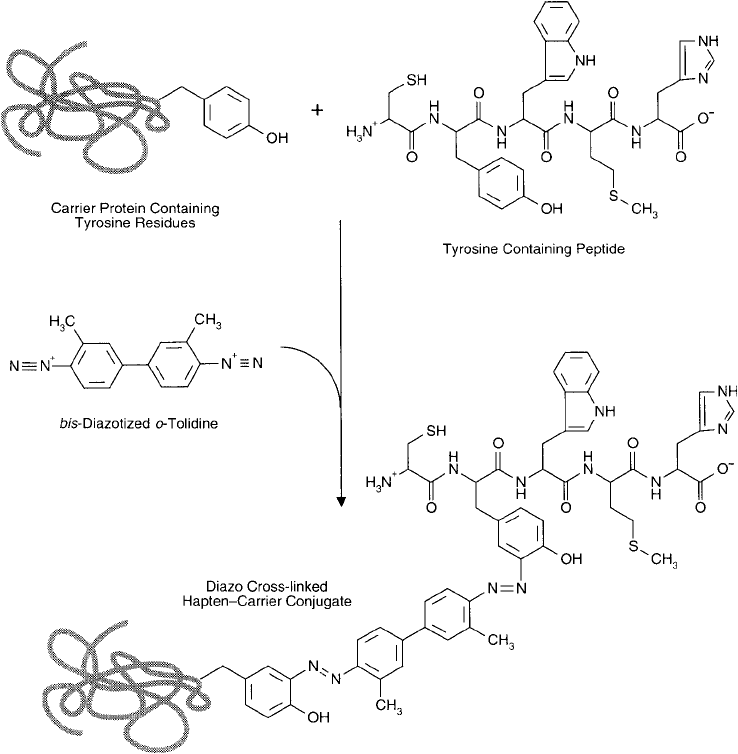
Diazo linkages are reversible bonds that may be cleaved by addition of 0.1 M sodium
dithionite in 0.2 M sodium borate, pH 9. Release of the crosslinks can be followed by loss of
the diazo bond color.
A simple, one-step conjugation reaction is possible with diazonium chemistry if a bis -
aminophenyl compound is used as a homobifunctional crosslinking agent. Activation of the
aminophenyl groups with sodium nitrite creates the requisite bis-diazonium derivative that
then can couple with active-hydrogen-containing haptens and carriers. In this way, tyrosine-
containing peptides can be conjugated with tyrosine-containing carrier proteins in a single step.
Compounds useful for this procedure include o-tolidine and benzidine (Chapter 4, Section 9),
both of which contain aromatic amines that easily can be diazotized ( Figure 19.23 ).
Figure 19.23 The conjugation of a tyrosine-containing carrier protein and a tyrosine-containing peptide may be
done using bis-diazotized tolidine to form diazo crosslinks.
6. Active-Hydrogen-Mediated Hapten–Carrier Conjugation 775
776 19. Preparation of Hapten–Carrier Immunogen Conjugates
From a practical perspective, however, any of the conjugation methods utilizing diazonium
chemistry can be problematic. The rate of reaction of the diazonium species is so rapid that
much of the total coupling potential can be lost through intramolecular crosslinking. As the
diazonium groups are formed they may immediately crosslink to the active hydrogens present
on the aminophenyl precursor molecules, even before addition of a second molecule to be con-
jugated. Even without addition of a second active-hydrogen-containing compound, the dia-
zonium activated molecule will turn brown to black within an hour, indicating formation of
diazo bonds and self-conjugation. For this reason, the reproducibility of conjugation reactions
using this method can be poor.
The following protocol describes the use of diazotized o-tolidine for the crosslinking of active-
hydrogen-containing haptens to active-hydrogen-containing carriers. Using a bis-diazonium
compound is perhaps the simplest method of conjugation, but as in many one-step crosslinking
procedures, it often results in some precipitation of the fi nal product. Reaction conditions may
have to be adjusted to prevent severe precipitation, however even an insoluble immunogen can
be useful in generating an antibody response.
Caution: Both o-tolidine and benzidine are potential carcinogens. Protective clothing, gloves,
and the use of a fume hood are recommended. Avoid all contact of the compounds with skin or
clothing and do not inhale vapors or dust.
Protocol
1. Diazotization of o-tolidine: Weigh out 25 mg of o-tolidine and place in a small test tube
or vial. Add 4.5 ml of 0.2 N HCl and mix to dissolve. Chill the solution on ice. Dissolve
17.5 mg of sodium nitrite into 0.5 ml of ice-cold deionized water, and add it to the vial
containing the o-tolidine. The solution should begin to turn an orange color, progres-
sively getting darker as the reaction continues. React for 1 hour on ice, mixing periodi-
cally. At the completion of the diazotization reaction, aliquots of the solution may be
stored at 20°C.
2. Dissolve 10 mg of carrier protein into 0.5 ml 0.15 M sodium borate, 0.15 M NaCl,
pH 9.0.
3. Dissolve 5–10 mg of a peptide hapten containing at least one tyrosine residue per ml of
0.15 M sodium borate, 0.15 M NaCl, pH 9.0.
4. Mix 0.5 ml of the peptide solution with 0.5 ml of the carrier protein solution. Chill on
ice. Add 0.4 ml of the bis-diazotized tolidine solution. There should be a color change
from orange to red almost immediately. Continue the reaction for 2 hours on ice in
the dark.
5. Purify the conjugate by gel fi ltration or dialysis using PBS, pH 7.4. The preparation is
now ready for immunization purposes.
6.2. Mannich Condensation
Another approach for crosslinking haptens to carriers when the hapten has no available
common functional groups (amines, carboxylates, sulfhydryls, etc.), but does possess active
hydrogens, is to use the Mannich reaction. Using this strategy an active-hydrogen-containing
compound can be condensed with formaldehyde and an amine in the Mannich reaction resulting

in a stable alkylamine linkage. Particularly, compounds containing replaceable hydrogens pro-
vided by the presence of certain activating chemical constituents can be aminoalkylated using
this reaction (see Chapter 2, Section 5.4 and Chapter 4, Section 6.1 for additional information
on active hydrogens).
In its simplest form, the Mannich reaction consists of the condensation of formaldehyde (or
sometimes another aldehyde) with ammonia, in the form of its salt, and another compound con-
taining an active hydrogen. Instead of using ammonia, however, this reaction can be done with
primary or secondary amines, or even with amides. An example is illustrated in the condensation
of acetophenone, formaldehyde, and a secondary amine salt (the active hydrogens are shown
underlined):
C H COCH CH O R NH HCl C H COCH CH NR HCl H O
65 3 2 2 65 2 2 2 2
→
The Mannich reaction provides a viable alternative to the diazonium conjugation method (dis-
cussed previously), because of the disadvantages inherent in the instability of both the diazonium
group and the resultant diazo linkage. By contrast, conjugations done through Mannich conden-
sations result in stable covalent bonds.
The crosslinking scheme using this method can make use of the native - and N-terminal
amines on carrier proteins as the source of primary amine for the condensation reaction. Added
to the conjugation reaction then is formaldehyde and the desired hapten to be coupled contain-
ing an appropriately active hydrogen.
To increase the yield of conjugated hapten using this procedure, cBSA is used as the carrier
protein in the method described below (see Section 2.1, this chapter for additional information
on this carrier). The greater density of amine groups on cBSA available for participation in
the Mannich reaction over that available on native proteins provides better results in coupling
active-hydrogen-containing haptens.
One note of caution should be realized when using the Mannich reaction. The hapten to be
coupled should not contain any amine groups or hapten polymerization may occur preferential
to conjugation to the carrier. For instance, when performing site-directed coupling of tyrosine-
containing peptides through their phenolic side chain, the diazonium reaction should be used
instead of the Mannich procedure, otherwise peptide-to-peptide coupling may occur.
Protocol
1. In a vial or test tube the following are placed and mixed:
a. 200l of a solution containing 10 mg/ml cBSA (Thermo Fisher) in 0.1 M MES, 0.15 M
NaCl, pH 4.7 (coupling buffer). The acidic conditions of this coupling buffer are opti-
mal for the Mannich reaction.
b. 200l of a solution consisting of 10 mg/ml of a hapten containing an active hydrogen.
The solution can be made up in absolute ethanol in the case of water-insoluble haptens
and is made up in coupling buffer in the case of water-soluble haptens.
c. 50 l of additional absolute ethanol in the case of water-insoluble haptens.
d. 50 l of 37 percent formaldehyde (Sigma) solution.
Caution : Use a fume hood and avoid contact or inhalation of vapors.
6. Active-Hydrogen-Mediated Hapten–Carrier Conjugation 777
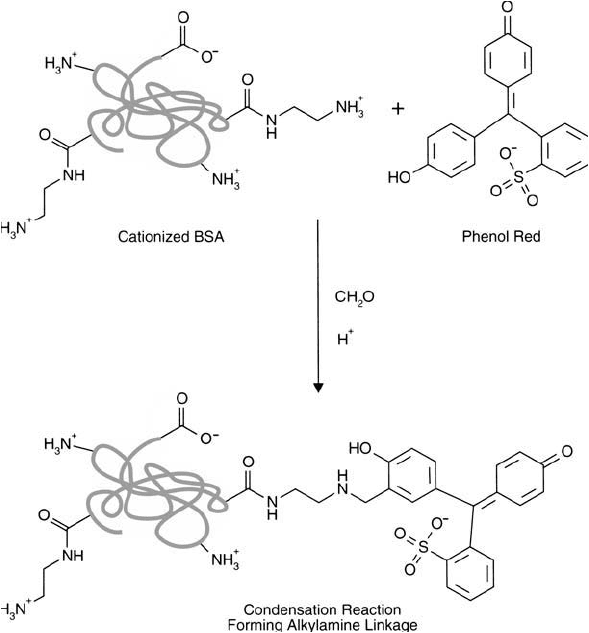
778 19. Preparation of Hapten–Carrier Immunogen Conjugates
2. Incubate the reaction mixture in a water bath or oven at a temperature of 37–57°C for a
period of 3–24 hours.
3. To separate unconjugated hapten and formaldehyde from the synthesized conjugate,
apply the entire volume of reactants to a desalting column containing a bed volume of at
least 10 times the volume of the reaction mixture. PBS, pH 7.2 can be used for the desalt-
ing step. The purifi ed conjugate is recovered in the void volume.
The yield of conjugation using the Mannich reaction is dependent on the reactivity of active
hydrogens within the hapten molecule. It is often diffi cult to predict the relative reactivity of
any given compound in this reaction. Thus, trial and error may be necessary to determine the
suitability of the Mannich procedure.
Figure 19.24 shows the conjugation reaction of the dye phenol red to cBSA using the
Mannich reaction. The active hydrogens which participate in the conjugation are ortho to
the hydroxyl group on the phenol ring. After purifi cation of the conjugate by gel fi ltration
to remove any unconjugated dye and formaldehyde, a wavelength scan was done to assess
the degree of conjugate formation. Figure 19.25 shows the results of this scan. The protein
Figure 19.24 The conjugation of phenol red to cBSA using the Mannich reaction.
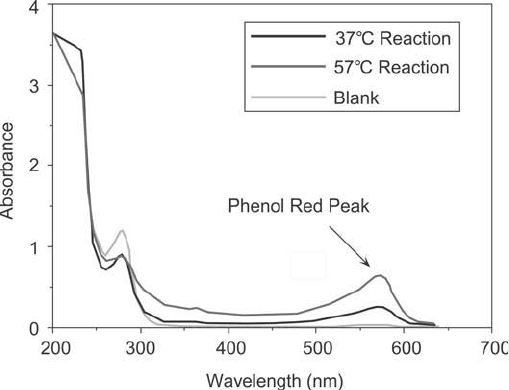
Figure 19.25 Absorbance scan comparing unconjugated cBSA with the same carrier that had been coupled with
phenol red using the Mannich reaction. Two different reaction times are compared, indicating that extended
reactions yield increased conjugate formation.
solution appeared red after conjugation and desalting, indicating successful crosslinking had
occurred.
The steroidal compound 17 -estradiol was also conjugated to cBSA using the Mannich
reaction. Similar to phenol red, conjugation with estradiol occurs ortho to the hydroxyl group
on its phenolic ring ( Figure 19.26 ). After purifi cation of the conjugate by gel fi ltration, it was
injected in mice intraperitoneally using alum as adjuvant. Antibodies were successfully pro-
duced against the coupled estradiol. Controls consisting of unconjugated estradiol with and
without mixed carrier molecules also were injected, but resulted in no antibody production.
7. Glutaraldehyde-Mediated Hapten–Carrier Conjugation
The homobifunctional crosslinking reagent glutaraldehyde can be used in a one- or two-step
conjugation protocol to prepare hapten–carrier conjugates. Glutaraldehyde can react with pri-
mary amine groups to create Schiff bases or double bond (Michael-type) addition products
(Chapter 4, Section 6.2). The Schiff base intermediate may form resonance-stabilized products
with the , -unsaturated aldehydes of the glutaraldehyde polymers predominating at basic pH
values (Korn et al., 1972; Monsan et al., 1975; Peters and Richards, 1977). One such prod-
uct, a quaternary pyridinium complex, can form as a crosslink between two lysine residues
(Chapter 1, Section 4.4). Reduction of the Schiff bases with sodium borohydride or sodium
cyanoborohydride yields stable secondary amine linkages.
The reaction of glutaraldehyde with protein carriers and peptide haptens involves mainly
lysine -amine and N-terminal -amine groups. The conjugates formed are usually of high-
molecular weight and may cause precipitation products. In addition, the orientation of the
7. Glutaraldehyde-Mediated Hapten–Carrier Conjugation 779
